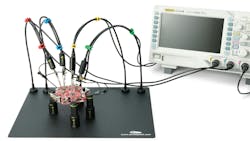This video is part of the Series Library: Kit Close-up.
What you’ll learn:
- What is PCBite?
- Why PCBite is a must have for development and prototyping with compact PCBs.
I work a lot with development kits and particularly like to prototype robotic projects. I first saw Sensepeek’s PCBite at the Sensors Converge conference and thought it was a great idea. Luckily, I was able to check it out myself with some of my projects (see the video above).
PCBite consists of a metal base that works with spring-loaded magnetic standoffs and flexible arms with a magnetic base (see figure). The latter can be oscilloscope probes or wire probes for things such as digital multimeters (DMMs). The parts are available individually or as a kit. There’s even a magnifying glass with a magnetic base that can be positioned to view any area, which can be handy for checking very tiny LEDs or placement of the probes.
The standoffs have a very strong spring; just one can handle small printed circuit boards (PCBs). Large PCBs can be managed with two or more standoffs. I usually find three standoffs are more than sufficient unless I’m dealing with a very large PCB.
Support for the probe is another matter. The flexible arms keep the cabling out of the way, but they don’t actually provide support. If you let go of the weighted end, it will just drop to the ground. Instead, that weight is designed to hold the probe in place. The points are spring-loaded so that you essentially touch the probe to the point on the circuit you want to track and press the weighted holder down to lock things into place.
I had a pair of oscilloscope probes and two regular probes, which turns out to be enough for most of my work. The hands-free operation becomes easier and trying to get the probe onto a very tiny PCB trace or pad was usually simple to do. Of course, attempting to get three or four of the probes into adjacent pins can be a challenge, but it’s often doable with careful positioning.
PCBite doesn’t work if you’re trying to probe the bottom of a board. It may still pay to use clips in some instances as well, though mixing probing techniques is second nature for most developers. Whatever works is the way to go. At this point, PCBite is a new tool in my prototyping and testing toolbox.
Check out more videos in the Series Library: Kit Close-up.
